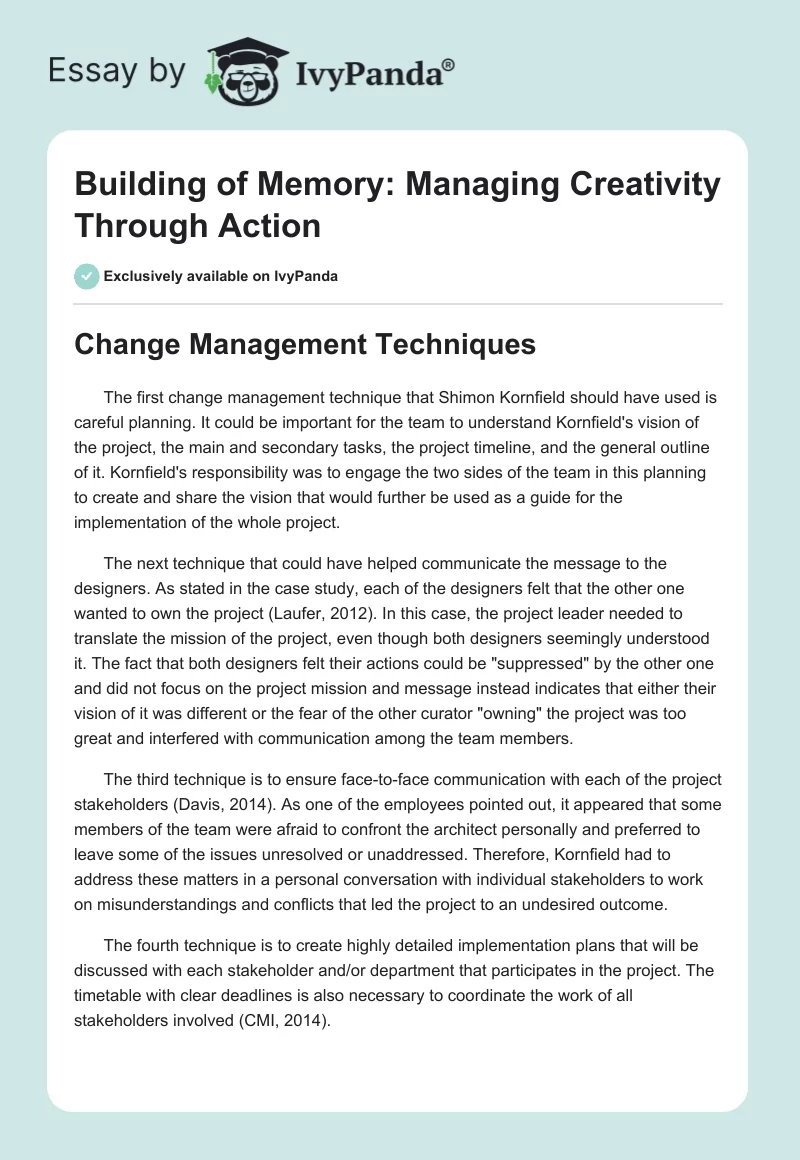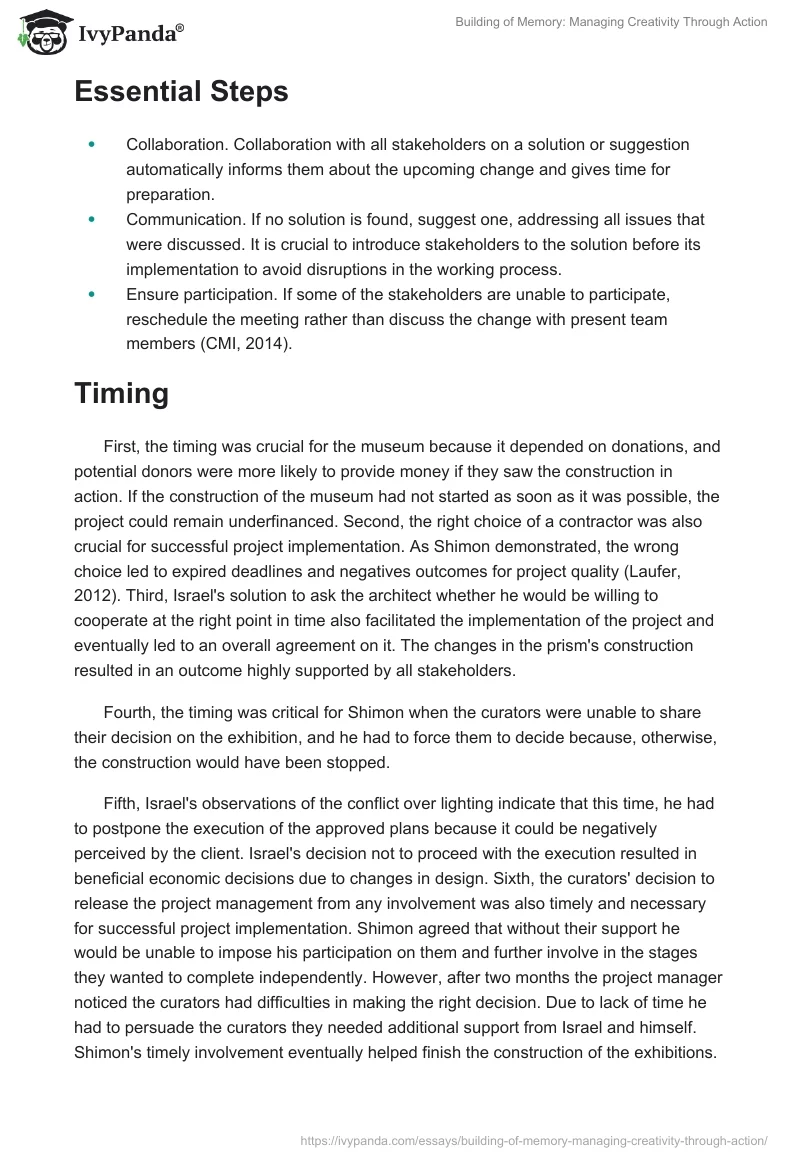Change Management Techniques
The first change management technique that Shimon Kornfield should have used is careful planning. It could be important for the team to understand Kornfield’s vision of the project, the main and secondary tasks, the project timeline, and the general outline of it. Kornfield’s responsibility was to engage the two sides of the team in this planning to create and share the vision that would further be used as a guide for the implementation of the whole project.
The next technique that could have helped communicate the message to the designers. As stated in the case study, each of the designers felt that the other one wanted to own the project (Laufer, 2012). In this case, the project leader needed to translate the mission of the project, even though both designers seemingly understood it. The fact that both designers felt their actions could be “suppressed” by the other one and did not focus on the project mission and message instead indicates that either their vision of it was different or the fear of the other curator “owning” the project was too great and interfered with communication among the team members.
The third technique is to ensure face-to-face communication with each of the project stakeholders (Davis, 2014). As one of the employees pointed out, it appeared that some members of the team were afraid to confront the architect personally and preferred to leave some of the issues unresolved or unaddressed. Therefore, Kornfield had to address these matters in a personal conversation with individual stakeholders to work on misunderstandings and conflicts that led the project to an undesired outcome.
The fourth technique is to create highly detailed implementation plans that will be discussed with each stakeholder and/or department that participates in the project. The timetable with clear deadlines is also necessary to coordinate the work of all stakeholders involved (CMI, 2014).
Essential Steps
- Collaboration. Collaboration with all stakeholders on a solution or suggestion automatically informs them about the upcoming change and gives time for preparation.
- Communication. If no solution is found, suggest one, addressing all issues that were discussed. It is crucial to introduce stakeholders to the solution before its implementation to avoid disruptions in the working process.
- Ensure participation. If some of the stakeholders are unable to participate, reschedule the meeting rather than discuss the change with present team members (CMI, 2014).
Timing
First, the timing was crucial for the museum because it depended on donations, and potential donors were more likely to provide money if they saw the construction in action. If the construction of the museum had not started as soon as it was possible, the project could remain underfinanced. Second, the right choice of a contractor was also crucial for successful project implementation. As Shimon demonstrated, the wrong choice led to expired deadlines and negatives outcomes for project quality (Laufer, 2012). Third, Israel’s solution to ask the architect whether he would be willing to cooperate at the right point in time also facilitated the implementation of the project and eventually led to an overall agreement on it. The changes in the prism’s construction resulted in an outcome highly supported by all stakeholders.
Fourth, the timing was critical for Shimon when the curators were unable to share their decision on the exhibition, and he had to force them to decide because, otherwise, the construction would have been stopped.
Fifth, Israel’s observations of the conflict over lighting indicate that this time, he had to postpone the execution of the approved plans because it could be negatively perceived by the client. Israel’s decision not to proceed with the execution resulted in beneficial economic decisions due to changes in design. Sixth, the curators’ decision to release the project management from any involvement was also timely and necessary for successful project implementation. Shimon agreed that without their support he would be unable to impose his participation on them and further involve in the stages they wanted to complete independently. However, after two months the project manager noticed the curators had difficulties in making the right decision. Due to lack of time he had to persuade the curators they needed additional support from Israel and himself. Shimon’s timely involvement eventually helped finish the construction of the exhibitions.
Establishing Trust and Gaining Credibility
One of the ways to develop trust and gain credibility among team members for the leader is to strive for both cognitive and affective trust. Supposedly, two key members (e.g. Israel and Ishai) were replaced. Kornfield’s responsibility would be to focus on building the relationships with the remaining team members using a cognitive trust (competence and skills) and affective trust (benevolence and empowerment of team members) (Zhu, Newman, Miao, & Hooke, 2013).
Another approach to gaining trust could be the framework of shared leadership. This type of leadership implies that the leader distributes leadership functions among the members of the group; this way, the coordination of the project and team members’ communication with each other and the leader can improve significantly (Drescher, Korsgaard, Welpe, Picot, & Wigand, 2014). If group members influence one another, they engage in a positive social exchange, which, in turn, leads to mutual influence and the development of more trustful relationships. To decrease the level of instability in the group, Kornfield needs to support other team members by showing them that their relationships and involvement are valued and that communication is actively encouraged in the team.
It should also be noted that it is impossible to gain credibility among followers if the leader is unable to be ethical, open, and fair. As Caldwell et al. (2012) point out, leadership is built on ethics and excellence, and to earn credibility the leader must combine character and competence. The leader’s ability to connect with followers individually will result in better performance of both; furthermore, it can also increase loyalty levels among team members and inspire them to suggest and provide innovations, thus making them equal contributors to the project.
Giving the employees credit for their achievements even if not all project disruptions are addressed is an option for Kornfield since it does emphasize his view of employees as equal (not subordinate) stakeholders with a particular vision of the project. Kornfield’s attention to the views of project participants is obligatory because if any of the expressed views are neglected, communication and collaboration among project members will disrupt instantly. Thus, the project manager would have to evaluate each of the contributions personally and choose a suitable suggestion without diminishing the role of other participants. Working on a project without key figures would be complicated, but with the right approach toward the remaining members, it could eventually result in success.
References
Caldwell, C., Dixon, R. D., Floyd, L. A., Chaudoin, J., Post, J., & Cheokas, G. (2012). Transformative leadership: Achieving unparalleled excellence. Journal of Business Ethics, 109(2), 175-187. Web.
CMI. (2014). Implementing an effective change programme. Web.
Davis, K. (2014). Different stakeholder groups and their perceptions of project success. International Journal of Project Management, 32(2), 189-201. Web.
Drescher, M. A., Korsgaard, M. A., Welpe, I. M., Picot, A., & Wigand, R. T. (2014). The dynamics of shared leadership: Building trust and enhancing performance. Journal of Applied Psychology, 99(5), 771-785. Web.
Laufer, A. (2012). Mastering the leadership role in project management. Upper Saddle River, NJ: FT Press. Web.
Zhu, W., Newman, A., Miao, Q., & Hooke, A. (2013). Revisiting the mediating role of trust in transformational leadership effects: Do different types of trust make a difference? The Leadership Quarterly, 24(1), 94-105. Web.


